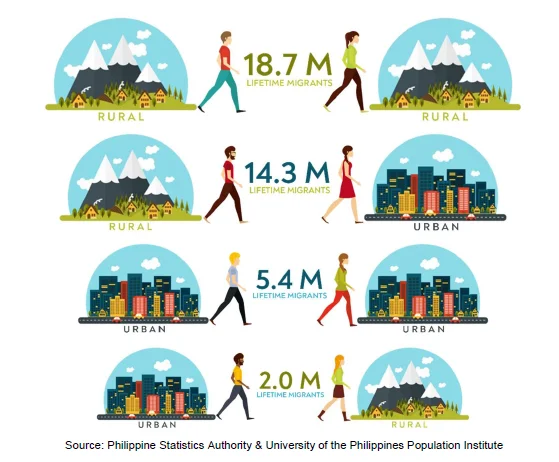Release Date :
Reference Number :
SR 2020-38
The 2018 National Migration Survey (NMS 2018) is the first nationwide survey on migration in the Philippines. It aims to provide information on the mobility of the Philippine population in order to assist policymakers and program managers in designing and evaluating strategies for improving services for, and assistance provided to, Filipinos going abroad or moving within the country. It was jointly implemented by the Philippine Statistics Authority (PSA) and the University of the Philippines Population Institute (UPPI).
This Special Release presents the migration experiences of Filipinos – levels and flows, migration experience of three months or more, migration in the last five years, and characteristics of migrants and non-migrants in the past five years.
Four in ten Filipinos are lifetime migrants
- The NMS 2018 data show that 40.1% of Filipinos aged 15 years and over are lifetime migrants, with females (43.3%) being relatively more migratory than males (36.8%).
- The most prevalent form of migration among these lifetime migrants was crossing regional boundaries at 57%. This was followed by inter-city/municipality migration at 31% and crossing of provincial boundaries at 13%. This pattern was true for both male and female lifetime migrants.
Figure 1. Percent Distribution of Population Aged 15 and Over by Lifetime Migration
Experience, Philippines: 2018

- A migration flow is characterized by its volume (i.e., the number of migrants entering or leaving an area) and its direction (i.e., the origin and destination areas of migrants). In 2018, the largest migration flows within regions or intra-regional flows occurred in Western Visayas, Central Visayas, and CALABARZON involving 2.43 million, 2.38 million, and 2.20 million lifetime migrants, respectively.
- Among all the regions, the least movement was recorded in the Cordillera Administrative Region with 542 thousand lifetime migrants. This was followed by CARAGA (739 thousand), and MIMAROPA (859 thousand).
- In 2018, there were more than four million lifetime migrants from other regions who moved to the National Capital Region. This was the largest inter-regional flow during the year. CALABARZON and Central Luzon came next involving 3.85 million and 1.37 million lifetime in-migrants. On the other hand, CAR, ARMM, and Cagayan Valley had the least in-migrants at 194 thousand, 158 thousand, and 299 thousand respectively.
- While having the largest volume of people moving in, NCR also had the most lifetime out-migrants or people transferring to other regions from NCR at 2.26 million migrants. This was followed by Bicol, Western, Central, and Eastern Visayas, each having more than a million lifetime out-migrants.
- Migration flows bring about population redistribution as regions gain and lose residents in the process. In terms of net number of lifetime migrants (i.e. in-migrants minus out-migrants) in 2018, CALABARZON and NCR were the top two gaining regions having 2.99 million and 1.77 million migrants while the top three losing regions were Bicol (1.42 million), Western Visayas (1.20 million), and Eastern Visayas (1.07 million).
Lifetime migrants most involved in rural to rural transfers
- Migration flows in 2018 were dominated by rural-rural movements involving 46.4% of lifetime migrants followed by rural-urban migration with 35.3%, urban-urban migration with 13.4%, and lastly urban-rural migration with 5.0% of migrants.
- More than half (52.6%) of the lifetime migrants were females. This means that females were more migratory than males (48.9%) in 2018.
Figure 2. Population Aged 15 and Over by Lifetime Migration Flow,
Philippines: 2018

Majority of Filipinos lived in another area for at least three months
- In general, 25,588 (55.2%) Filipinos moved to or lived in another place, whether in the Philippines or abroad, for at least three months.
-
Among those who ever migrated, 22,517 Filipinos have experienced internal migration only while 1,279 were involved in international migration only. Both internal and international migration were experienced by 1,791 Filipinos.
-
First time intra-regional migrants involving more than a million each were mostly within Central Visayas (1.74 million), CALABARZON (1.63 million), WesternVisayas (1.62 million), NCR (1.36 million), Central Luzon (1.23 million), Northern Mindanao (1.11 million), and Davao (1.09 million).
-
The top destinations of those who migrated abroad for the first time were Saudi Arabia, United Arab Emirates, Malaysia, Japan, Singapore, Taiwan, Kuwait, Hong Kong and United States of America.
Figure 3. Top Destination Countries of those Who Migrated Abroad for the First Time,
Philippines: 2018

Only 3 in 20 Filipinos migrated during the past five years
- During the past five years, only 3,782 (14.8%) Filipinos migrated, of whom 84% have internal migration experience only while 14% were involved in international migration only. Internal and international migration were experienced by 2% of the Filipino migrants.
- The largest intra-regional migration flows during the past five years, involving at least 250 thousand Filipinos each, occurred in CALABARZON (512 thousand), Central Visayas (372 thousand), Bicol (347 thousand), Western Visayas (292 thousand), NCR (281 thousand), Davao (269 thousand), and Eastern Visayas (261 thousand).
- In terms of internal migration that involved the crossing of regional boundaries, the regions with the largest number of in-migrants were NCR (388 thousand), CALABARZON (293 thousand), Eastern Visayas (186 thousand), Bicol (162 thousand), and Davao (111 thousand).
- On the other hand, regions with the most migrant outflows were NCR (509 thousand), CALABARZON (184 thousand), Central Luzon (109 thousand), and Bicol (103 thousand).
- Migration flows during the past five years were dominated by rural-rural movements involving 18,948 internal migrants followed by urban-urban migration with 17,990, urban-rural migration with 1,325, and lastly rural-urban migration with 1,259 internal migrants.
- Among those who migrated abroad in the past five years, the top destination countries were Saudi Arabia (20%), United Arab Emirates (15%), Japan (9%), Kuwait and Qatar (7% each), Malaysia (6%), United States of America and Taiwan (5% each).

